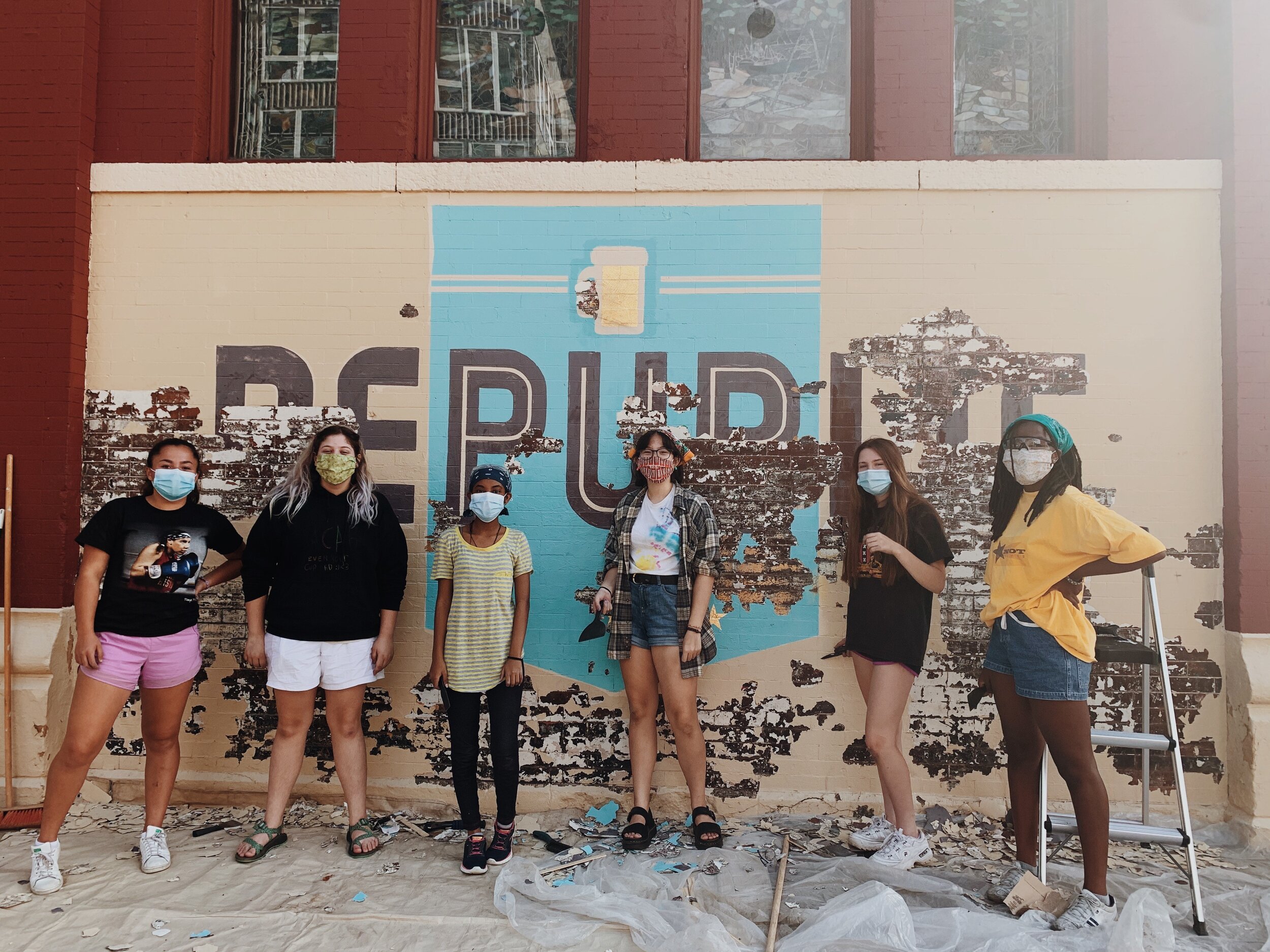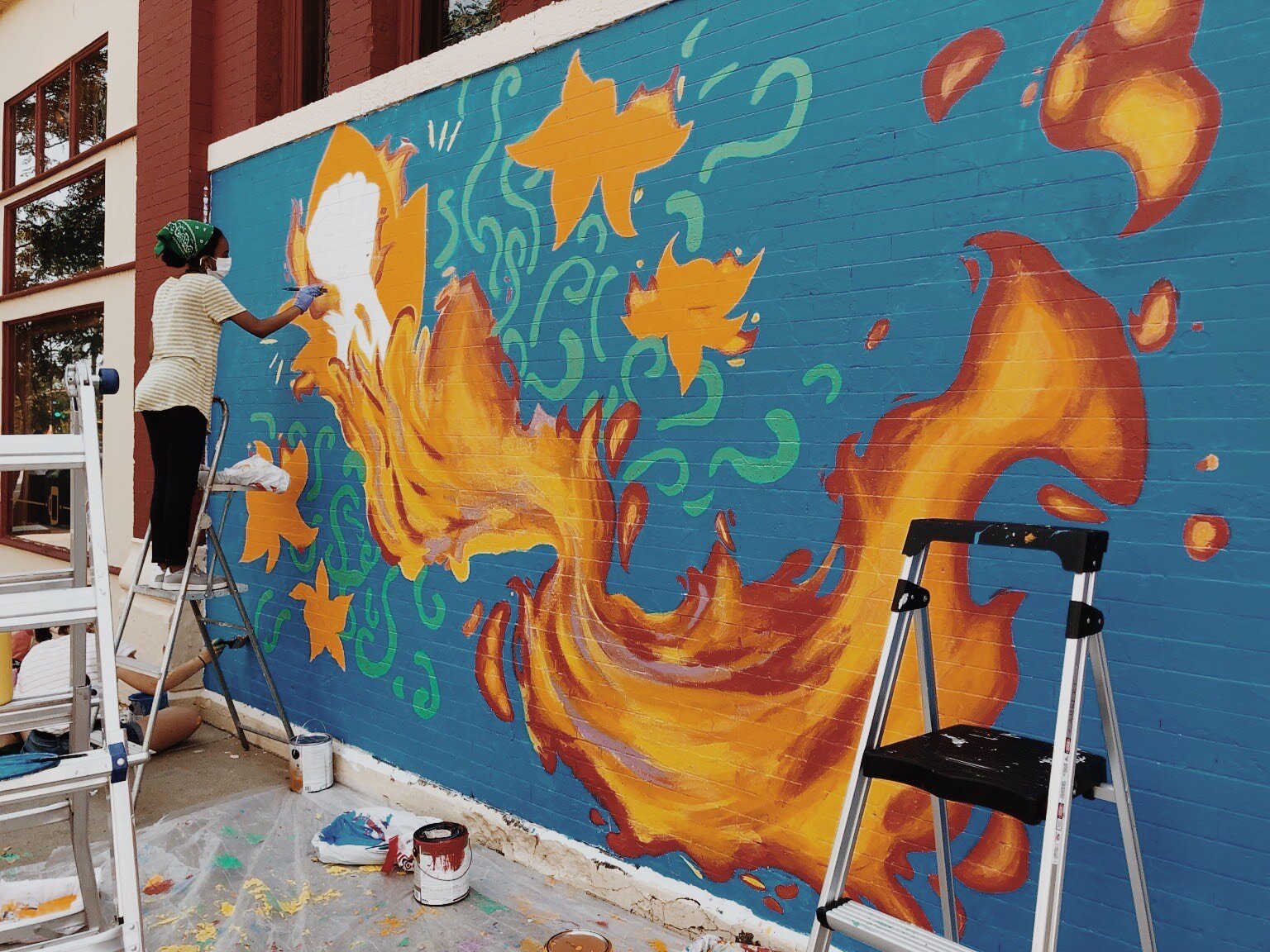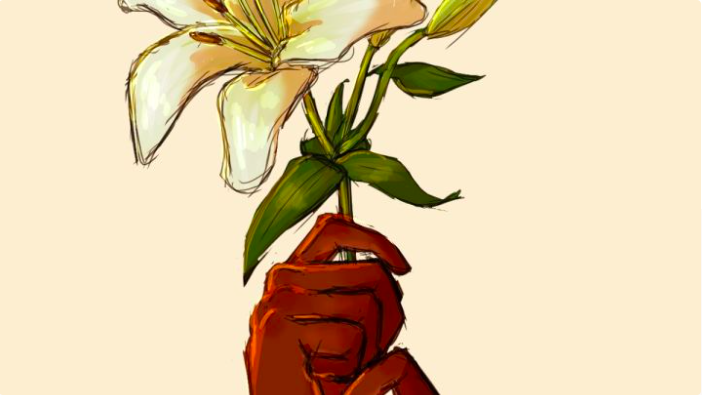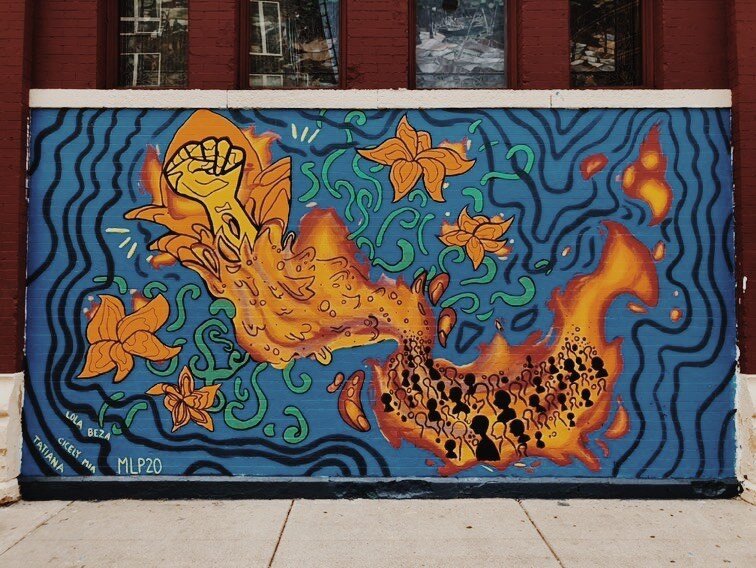Inspiring Change, One Mural at a Time
The Lily Project is a group of talented and motivated high school students from across the Twin Cities hoping to inspire change through art. As part of TCM’s series exploring compassion through the lens of art, Crystal met with two members of their team to learn more.
(From L to R): Lola Yost, Zoe Glaser, Bezawit Abate, Mia Lambert, Maya Pampuch, and Cicely Bass
Crystal: I just found out that you're all located at different schools. Is that right? There are 30 people involved, and you don't go to the same school?
Maddie Tatum (Sophomore): Yeah. Our whole little group got started by a few people--JoJo and Reese--who reached out to people over Instagram, where we started brainstorming. My first time meeting Mia was in June or at the end of May.
Crystal: Tell me about your mission to create murals in memory of George Floyd (and others affected by systemic injustices) and to support BIPOC-owned businesses. Why this mission, and why art?
Maddie: JoJo was inspired by that mural [of George Floyd] by Cub Foods. She asked if anyone was interested in making a mural. I think both JoJo and Reese were like, “Wow, we could do something like this to spread the word.” And then that's how we ended up getting connected.
I remember the week of all the unrest. I remember feeling like I couldn't do anything. I was having to stay inside, and I didn't know how to help, you know? I was signing petitions and I was trying to educate myself more. Art has always been a passion of mine, and I've always been able to have that as an outlet. So, when I saw JoJo’s Instagram story, I thought “this is really cool; this seems like something to which I can contribute.” Art is such an interesting way to express a lot of deep emotion. So, I could see something happening with it.
Mia Lambert (Sophomore): That’s pretty much exactly why I wanted to join, too. I felt like I could use my creativity to help out—beyond myself. Our big mission, as a group is to use art as a medium to come together as a community and collaborate. It's like a gathering of community, uniting all of our voices together as one and trying to make a change however we can. And for us that's through our art. Making murals is a really collaborative experience. There are so many different sides to the whole process, which allows many people to help out with it.
Crystal: What are the elements that go into doing a mural that make it a weaving of community?
It's like a gathering of community, uniting all of our voices together as one and trying to make a change however we can. And for us that's through our art.
Mia: Well, for us, it all started with a call for people to donate paint. We had a whole paint drive, organized by Maddie. Then we had people contacting businesses to find spaces for us to paint. There is someone handling all the finances, because in order to make something we need stuff to make it with. Any supplies you don't have, you have to buy. There are people helping with social media. We are on Facebook and Instagram right now, and then the whole website, which was also Maddie’s creation. I contact the artists and organize the design process--basically, what the mural is going to be. So, for the mural that we did [for The Republic Restaurant], I helped find the artists and design and made sure the whole process ran as smoothly as we could make it.
Maddie: Everyone has different strengths and talents. I knew that I like web design and have done it in the past. So, I said, “Hey, I can take this on if that's something we're interested in.” Other people had different experiences that they could bring to the table. People said, “I'm good at this.” That was really helpful for starting out.
Bezawit Abate, working on the mural she designed for The Republic Restaurant in Minneapolis
Crystal: Something in what you said made me think of the image on your GoFundMe page. There’s a hand holding a lily. It’s intimate, tender, and yet strong.
Maddie: The reason we are called the Lily Project is that we wanted to use the lily as a motif, so that all of our murals would be connected by the lily flower. The flower represents grieving for George Floyd and for all the other people who have been impacted by systemic racism. Also, the lily is flowering, growing, and blooming to represent rebirth, growth and change.
Crystal: Can you tell me where the inspiration came from?
Mia: I actually made that picture before the Lily Project was a thing. I love reading about the symbolism of flowers and using them in my art. I had created that image to help me after Memorial Day weekend with George Floyd and everything happening around us in Minneapolis. I remember bringing that up and I think that's the reason we all tumbled into the idea of using lilies. But basically, I wanted to use that flower symbolism.
Crystal: What’s remarkable about that image, for me personally, is how it’s simple, yet, like you said Maddie, captures so much – grieving, sadness, and hope. It pulls my heart into it. It makes me want to stay, look and listen.
Mia: Art has been a way for me to relax and explore my own world inside of my head. Art has really just been like my second life. I think that’s why art is so important to me. Using it for this sort of cause is like…I don't know … like using another voice. It’s my internal voice and putting that on paper is like using that internal voice to help create a stronger message.
Maddie: Yeah, art has also been a really big part of my life. I've always felt like it's just something that I love. What's really amazing with all of the art that has come up in the cities right now, is that it makes you think. And, it makes you feel something. That’s what I think is so powerful about art--just by looking at it--it can make something happen for people. It’s also nice to have an outlet for how you're feeling and for justice. Especially for our group.
When we were first talking, the two organizers, Jojo and Reese, ended up stepping back from leadership roles because they thought it was important to have someone of color leading it and leading discussions. I thought that was really awesome. It was really a learning experience for me. I saw that I can be an artist but know that my voice isn't the one to be focused on.
Crystal: What did you learn in those dialogues you were having?
Mia: That to lead isn't just about telling people what to do, but it's also to understand when it's time to step back and instead learn from the people you're leading, and create a more collaborative experience instead of just some sort of executive decision, which I feel is an important thing that happened within our group. People weren't trying to enforce their opinions or ideas on each other and but instead presenting them to the group as a question and then we collaborate and build off of it together.
Crystal: Wow. We can all learn from that. Thank you for sharing.
With respect to the murals or this project as a whole, what are your biggest hopes or aspirations in terms of impact? What do you hope comes out of this?
(Left to Right): Jacy Landi, Zoe Glaser, Ava Bur, Maddie Tatum, and Lily Lo with their standing mural at The Greenway Glow
Maddie: What we really want this project to do is to draw attention to the issues that are happening right now and realize that we need to see change here. I hope people will see that this is how we're taking action. This is a project run by a group of high school students. We can do it. If we can do it, then if other people put their minds to it… it’s an idea that everything's possible as long as there is hard work and there are people that really care about other people.
It’s an idea that everything's possible as long as there is hard work and there are people that really care about other people.
Crystal: So, you hope to inspire other young people to take action?
Maddie: Yeah, for sure.
Mia: For me, art is something that creates conversations that people have never thought of. Even if it’s abstract, like a blue line, there’s a question of “Why did the artist create it?” When you make those connections, you go deeper and have conversations--whether it’s a conversation within oneself or with others. It's another way of communicating with someone that doesn't necessarily have to use words.
Maddie: Yeah. It’s looking at something and having it come back at you with emotion, or a story or something. And if there's multiple people looking at one thing, they're not all going to think the same. So, when you're talking about compassion or community, having those conversations--whether it's about the art or something happening in the community -- art can draw people in to have the discussions that may be wouldn’t happen without the art. Art can do a lot of amazing things. Besides helping the person looking at it, it does a lot for the artist or for the people painting.
Crystal: Is there a particular conversation you hope people will have when they come into contact with your murals?
Mia: One of the biggest questions people will ask is, “What is this?” and “Why is this here?” The “Why is this here?” is important. It can mean so many different things, like “Why is it in the certain location or why is it being made?” The reason we're creating murals is to use our voices to speak out about the injustices around us within our society. If people ask the question, it will help them dive deeper into understanding the injustices depicted in the mural and want to know the history and a root of it. So, it’s to educate people, but also inspire people to educate themselves as well.
“The reason we’re creating murals is to use our voices to speak out about the injustices around us within our society. If people ask the question, it will help them dive deeper into understanding the injustices depicted in the mural and want to know the history and a root of it. ”







